World Health Organization says coronavirus could go either way as cases near 70,000

Speaking at a media briefing last week, the executive director of the World Health Organization made it clear that things are simply not clear. The epidemic of 2019-novel coronavirus that has generated tens of thousands of cases around the city of Wuhan may become a broad global pandemic … or not. Meanwhile, officials at health agencies around the world are bracing for the possibility of a broader outbreak. That’s a good thing. But no one should be assuming that a global pandemic is a foregone conclusion. Because it’s not.
In the same way, no one should be dismissing the possible effects of a widespread pandemic as “like a cold” or “no worse than the flu,” because we have all the evidence we need to see that is not true. A worldwide pandemic of novel coronavirus would be devastating both in terms of the lives and economic effects.
Over and over again, from the television pundits to the comments on every Daily Kos post, we’ve been reminded that the flu affects millions of Americans and has already killed over 11,000 in this year alone. That’s absolutely true. Flu, in the best year, is simply a horror we’ve learned to live with, and which many people treat far too casually. This isn’t even one of the best years.
But the idea that should the virus between COVID-19 sweep the world it would be, at worst, like a new source of flu, is way, way off base. Yes, the official case fatality rate for those hospitalized with the flu is often quite high—above 7%. The official case fatality rate for COVID-19 is currently only between 2% and 3%.
The two things are not comparable. They’re not comparable because, to the extent that is possible, everyone who is determined to be infected with the virus behind COVID-19 is currently being counted as a case. Whether it’s the 50,000 people who have proven to have the virus through lab testing, or the additional 20,000 who are showing clinical signs, everyone who is suspected of having COVID-19 is part of that case count. You don’t have to be in serious or critical condition to be added to the case load for COVID-19.
In the United States alone, some 20 million people will have flu this season. The actual chances that a case of flu will result in death is something less than 0.1% — and it still generates tens of thousands of deaths. If even the broadest assumptions are taken about the relationship between the cases that we’re now counting and the actual pool of coronavirus out there, the numbers are at least 6 times worse than flu. If the case count is actually close to the total pool, then the number is more like 30 times worse.
And there are very good reasons to believe that the real effect of widespread cases of COVID-19 would be hugely worse than even those numbers suggest. Because we’re seeing what that looks like on the ground in Hubei province.
Outside Hubei, the outcome for those who have COVID-19 remains optimistic, with only 3 deaths compared to 130 people who have recovered. Inside Hubei, the outcomes are very different. On Sunday, the outcome mortality in Hubei remained close to 15%. That is the difference between dealing with this infection in a handful of cases, and dealing with it in huge numbers.
The biggest reason for that difference is likely one simple factor: Oxygen. About 25% of patients with the closely-related SARS virus require some form of respiratory assistance to make it through. The for those infected with the other member of this beta coronavirus triptych, MERS, that requirement is 80%. Why did MERS overwhelm a wealthy Saudi city and generate 600 deaths in just 2,000 cases? Because it quickly exceeded the ability of the system to provide the level of treatment that patients require to survive. That’s happening in Hubei right now with COVID-19.
In short, if 20,000,000 Americans were infected with COVID-19, somewhere between 2,000,000 and 4,000,000 of those infected would probably require a hospital bed with respiratory assistance, or they would die. And guess what? The reason there are only 20,000,000 cases of flu is because many people do get flu shots and many people do have some latent resistance to the the type of flu circulating in any give year. So for COVID-19 take that 20,000,000, and multiply it by everyone.
Yes, endemic human coronaviruses cause about 15% of colds. This isn’t one them. Organizations like WHO and the CDC don’t keep novel beta coronaviruses at the top of their global pandemic threat lists because they’re worried about increasing the global need for Puffs plus lotion. They do it because these diseases are rat bastards that will kill millions if they get out.
Okay, let’s do numbers. Because those are looking pretty hopeful.
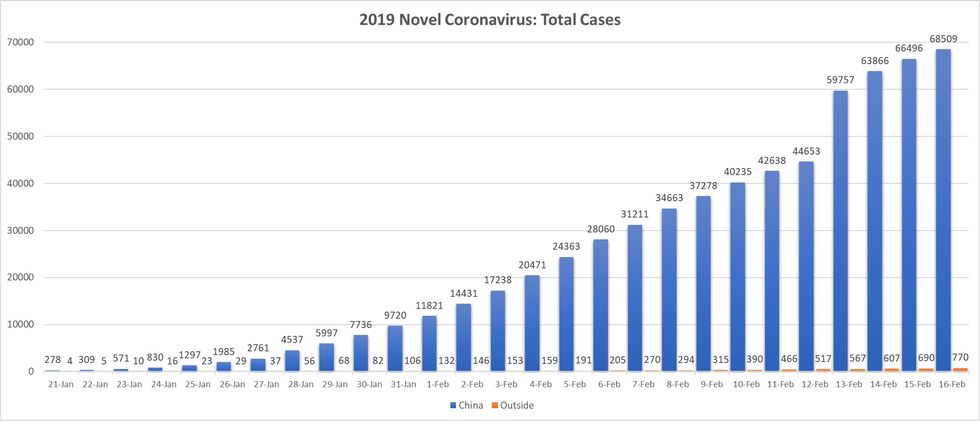
Several days later, it’s easy to see that the big and terrifying spike that happened when officials in Hubei province began reporting clinically-diagnosed cases wasn’t a harbinger of “Go to bunker, go immediately to bunker, do not pass grocery story for one last can of beans, just slam that door!” Instead, it was more of a cleaning of the books. Any upward movement is bad. But now it’s a helluva lot less bad.
Here’s out that looks on a daily basis.
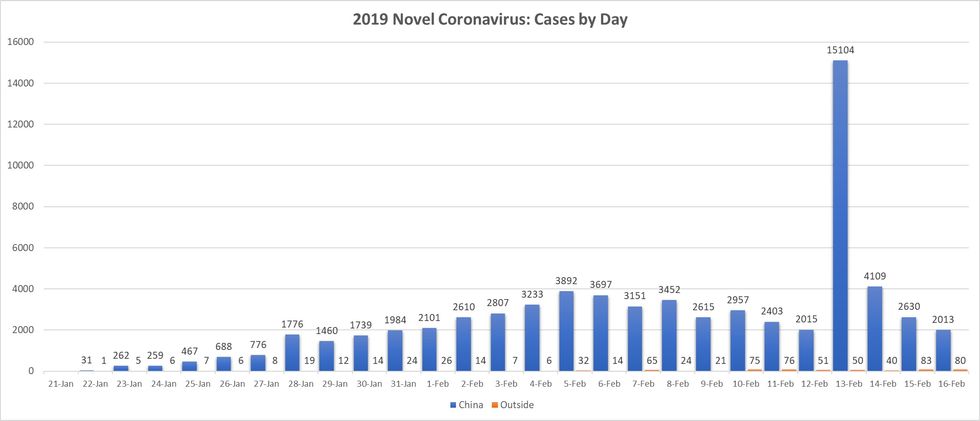
This shows a disease that, once again, is very much on its way to being at least somewhat controlled. There are some concerns about the cases popping up outside China, and we’ll get to some of that shortly. But if you scrub the clinical cases off of those numbers, it shows numbers that peaked ten days ago and have been in a steady, if somewhat uneven, decline. Check the new chart that’s been added to the WHO dashboard if you want to see how things look with only the lab-tested cases on the books.
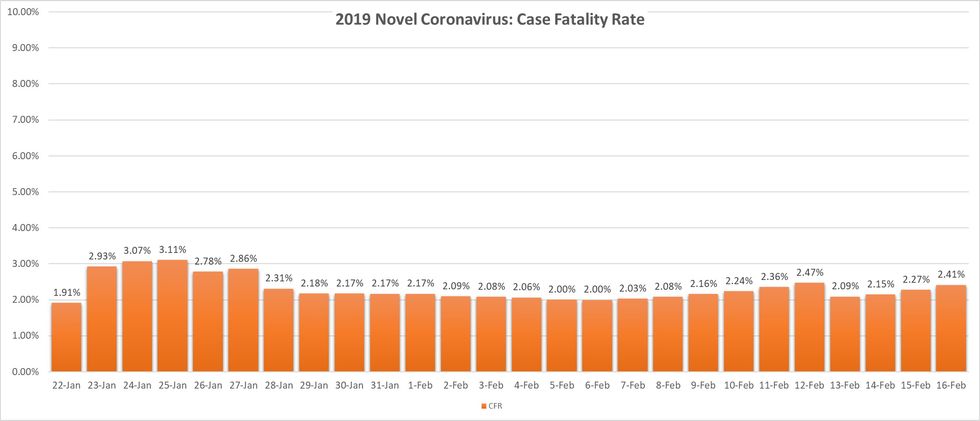
The case fatality rate (total deaths / total cases) took a tick down when the load of clinical cases were added. As we saw on previous days, that seems to be because the clinical cases are in general milder than those which have been lab confirmed. Considering the quarantine conditions that have been featured in some really shocking videos out of China, its likely that only a fraction of even lab-tested cases are in hospital beds. The decline in the number of clinical cases — from 13,000, to 4,000, to 2,000, to 1,000 — over just a few days hopefully indicates that health care workers have cleared up their backlog of cases. But we should all try to not get disheartened if there’s another spike of these cases ahead.
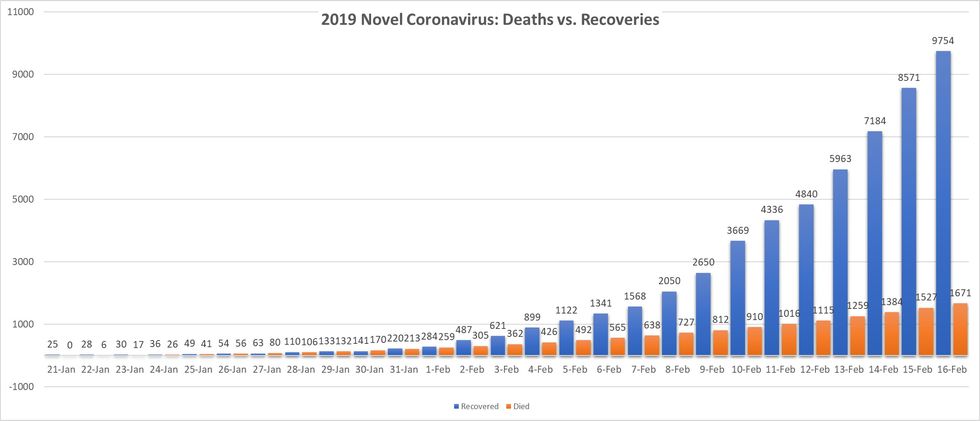
The number of deaths in reports on Sunday morning actually matches the worst total to date (144). But that number has been almost steady for four days (144, 125, 143, 144) while the number of recoveries has finally moved above 1,000 a day. That’s genuinely good news.
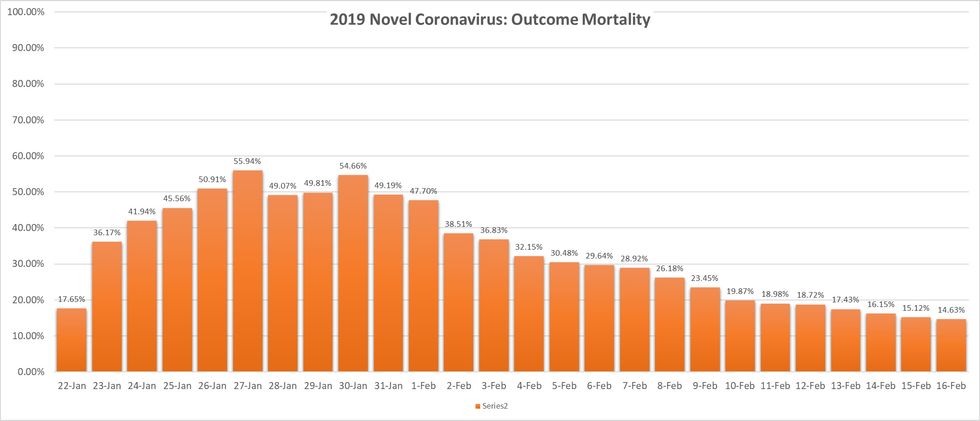
So even though the number of deaths per day has been more or less flat, the increasing number of cases reported as recovered is pushing outcome mortality ever lower. It’s not going down as fast as anyone would like, but today may be the first day where the number of active cases in Hubei was pretty much the same as it was yesterday. China is currently listing 11,000 cases as “severe” or “critical.” The odds of each of those severe cases receiving the treatment necessary to drastically improve outcomes could be just a few days away.
| RECOVERED | DIED | |
|---|---|---|
| CHINA | 9,754 (+1,312) | 1,666 (+143) |
| OUTSIDE | 129 (+25) | 4 (+1) |
In Singapore, another cluster of cases appears to be connected to Grace Assembly of God church, which has already been the source for almost half the cases in the nation. These also include some secondary cases where people who appear to have acquired an infection at the church have spread it to others. To all those people who have cancelled conferences large and small … thank you.
The single new death comes from Taiwan. It involves a taxi driver who had never left the country. There have also been a burst of cases in Japan in the last few days involving taxi drivers. Apparently that plastic shield (assuming they have one in Taiwan and Japan) is far from germ proof. Considering how many people may have hopped into a cab right after someone infected, or even shared a ride from the airport, this is certainly a concerning vector.
Speaking of Japan, they had six new cases — not counting the cases on board the Diamond Princess. Japan and Singapore continue to be sources of special concern when it comes to establishment of a second epicenter outside of China.
And finally, most of the Americans on the Diamond Princess are coming home, with what seem to be pretty good precautions. Those patients already displaying symptoms, or who have tested positive for the COVID-19 virus, will remain in Japan— either on the ship, or in quarantine at a Japanese hospital. Other passengers are also being given the choice of being quarantined in Japan. Those that come back to the United States will do so on a charter flight where part of the plane is isolated to take any passengers who begin to show any symptoms in flight. Finally, all passengers will go into a 14-day quarantine when they land in the United States. It’s hard to find a lot of fault with that process.
So long as they’re careful. Because one of the cases in Japan is a quarantine officer who has been working outside the ship.
Resources
World Health Organization 2019 Coronavirus information site.
World Health Organization 2019 Coronavirus Dashboard.
2019-nCoV Global Cases from Johns Hopkins.
BNO News 2019 Novel Coronavirus tracking site.
Worldometer / Wuhan Coronavirus Outbreak.
Some issues tackled on previous days
Why COVID-19 was not made in a bioweapon lab.
How Case Fatality Rate and other measures are calculated.
Looking at incidence in other Chinese provinces.
The death of whistleblowing Dr. Li Wenliang triggers calls for free speech.






